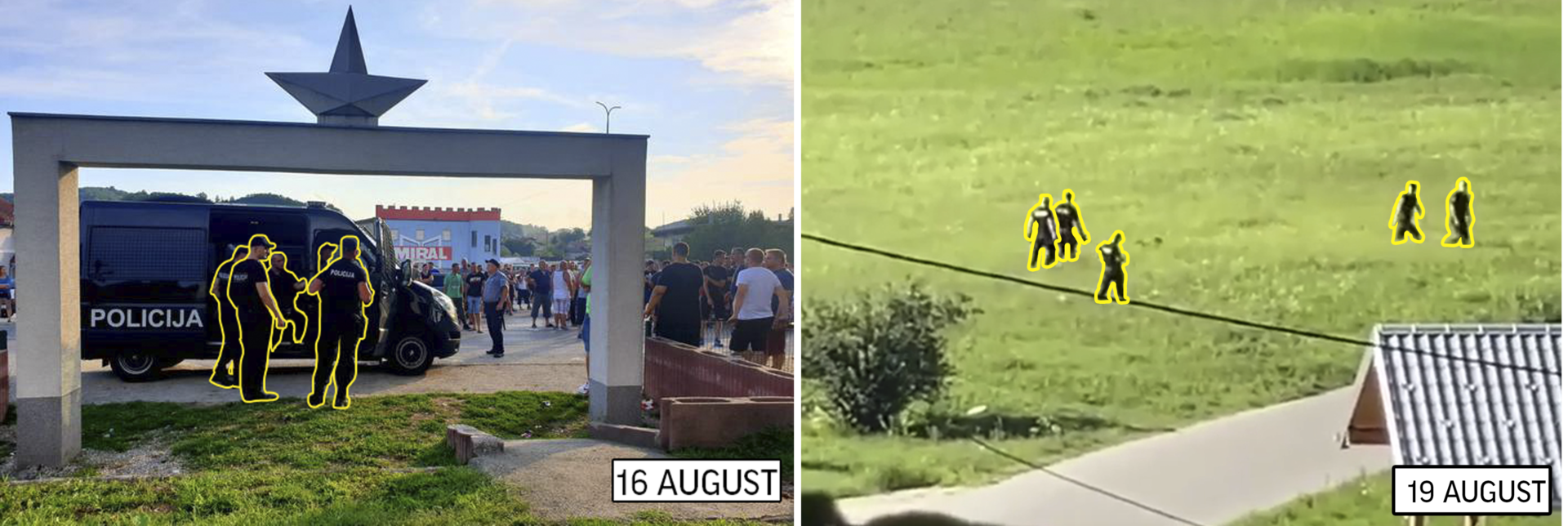The following piece is a product of a joint-investigation on behalf of the Border Violence Monitoring Network.
Introduction
During the month of August, local initiatives organizing against the existence of an informal transit camp near the IOM-run transit center in Velika Kladuša heightened tensions within the Una-Sana Canton. In this time, people-in-transit have been cleared twice from the improvised shelters built around the official camp by authorities, but tensions have continued to climb. During this period, some locals began demonstrations which turned aggressive in some cases and violent in others.
By mid-August, there were regular demonstrations outside of the IOM-run transit camp wherein incoming buses would be stopped and searched for people-in-transit who, if identified, would be taken off and told to walk back in the direction they came from. Additionally, hateful Facebook groups amassed thousands of followers during this month, discussing ways in which to aggressively deal with people-on-the-move and aid volunteers living in the Una-Sana canton. Elsewhere, official cantonal policy refugees and migrants have shifted, wherein transit groups are actively being prevented from entering the Una-Sana Canton.
During this time of heightened tension, serious physical attacks on people-in-transit have been reported in northwest Bosnia. In this context a video, recorded on the 19th of August in Velika Kladuša, began surfacing around social media networks, apparently showing men after and beating a refugee in an open field .
In this investigation, we will analyze the information contained within this clip in order to better understand its content and identify the individuals involved in the incident. In order to accomplish this, we utilized various open-source techniques such as geolocating the video using satellite imagery, stitching together the scene with compiled images, and conducting research on the origins of the vehicle parked at the scene.
Geolocation
Since the video is quite brief and provides few context clues, our first step was to stitch together the scene using stills from the video.
Photo-stitch panorama from the video of the violent incident on 19 August
Once this was done, several things about the landscape in which the clip was filmed become clear. Namely, that it depicts three separate building structures – two with the red-brick roofing typical to houses in this area of the Balkans, and another with distinct white-roofing. In addition, we can in the background a slightly curved paved road, an unpaved dirt road running perpendicular to the former, and what appears to be an overgrown and vacant concrete lot in the upper left of the image. Using this information we were able to identify via satellite imagery these structures and locate the exact location where this video was filmed.
Satellite view of the geolocated incident location, showing building structures
Photo-stitch panorama from the video of the violent incident on 19 August, showing identified building structures
Importantly, this area outside of Velika Kladuša is in the immediate vicinity of the IOM-run Miral Camp which houses hundreds of people-on-the-move and has been the focal point of anti-migrant protests in the area in the last weeks. In the area surrounding Miral Camp, there has been an informal tent settlement the last months with hundreds of residents who were either unable or unwilling to stay inside of the official camp. Moreover, many disused houses in the surrounding area serve as squats for the community’s considerable out-of-camp population.
Satellite display of the incident location in reference to the nearby Miral Camp
Identifying the vehicle seen in the video
An initial concern in this investigation was identifying the vehicle featured in the video clip. Accomplishing this would allow us to draw broader conclusions about the perpetrators of the violent attack shown in the clip.
At first glance, the vehicle appears to lack distinctive markings or insignia which would allow us to identify it. Under closer analysis, however, we were able to analyze characteristics of the vehicle, allowing us to conclude it’s make and model. The vehicle in the video clip matches the distinctive, vertical rear tail lights as well as a left-of-center license plate framing. It has a small ridge on the top of the vehicle towards the front, indicating emergency lights. It has a distinctive dark blue paint job which verges on black. Moreover, the white lettering is visible on the lower right hand side of the car’s frame – ostensibly spelling “POLICIJA”.
With this in mind, the vehicle in frame closely matches the profile of one of the three 2020 Renault Master operated by the Una-Sana Canton’s police force, which were observed frequently in the area on refugee-related security tasks during the month of August. On August 4th, during the clearing of the informal tent camp near Miral, at least one of these vehicles were present. On August 8th, two of the vehicles were photographed parking at the local police station in Velika Kladuša. Between August 16th and 20th, the vehicle was seen on at least four separate occasions in the Velika Kladuša area, engaged in tasks related to the recent unrest in the area.
Top Left: Comparing the vehicle in the incident clip to the 2020 Renault Master; Top Right: Identification of key features on the vehicle in the incident clip; Bottom: Presence of the USK-MUP’s Renault Master vans near Velika Kladusa in the month of August The Una-Sana Canton’s Ministry of the Interior has a total of three 2020 Renault Master vehicles. They were obtained in the beginning of October, 2019 from the IOM, who donated these cars as part of its EU-funded mission in the country. According to the IOM, the donation was managed through the project “EU Support to Migration and Border Management in Bosnia and Herzegovina” which “is funded by the European Union with €14.8 million and is implemented by the IOM in partnership with UNHCR, UNICEF, UNFPA and the Danish Refugee Council (DRC).”
The EU’s funding of equipment for Bosnian authorities engaging in migration enforcement via the “EU Support to Migration and Border Management in Bosnia and Herzegovina” project has been considerable. In addition to the three 2020 Renault Master vans, the IOM has facilitated the donation of eight cameras, two boats, five SUVs, 35 radios, and 45 computers to the USK-MUP and the Bosnian border police in between October and December 2019 alone. This represents more than 200,000 EUR of support to the Bosnian border police and USK-MUP in the last year.
Identifying the Individuals Seen in the Video
IOM Coordinator for the Western Balkans Peter Van Der Auweraert hands over the keys of three Renault Master vans to USK Prime Minister Mustafa Ružnić in October, 2019. Note the presence of a Special Support Unit inspector to the left hand side of the image With the vehicle in the clip reliably identified, it was possible for us to attempt to draw further conclusions about the specific individuals shown in the clip. In the video, two men are seen initially running after the alleged refugee, punching the individual to the ground and moments later jumping on him. Shortly after this, three more men dressed in identical uniforms walk into the left side of the frame. All five men then walk back to the Renault van, along the way, one of the men takes an item from the injured man and kicks it with his foot.
Aside from identifying these individuals as Bosnian police officers, a key consideration in this investigation was determining what their unit affiliation was. Although it is difficult to identify facial features in the clip, due to the poor quality of the footage, we can note the uniformed nature of their appearance, with all five men being clad in black pants and short sleeved t-shirts. Importantly, a white lettering can be made out on each of the men’s backs from afar.
The appearance of the men shown in the clip from August 19th is strikingly similar to the pants and shirt combo of a group of five officers photographed near the same 2020 Renault Master on August 16th. At the time of the picture, the group was parked outside of Miral Camp, less than a kilometer away from where the video would be taken three days later. While it is impossible to say whether these are the same individuals recorded on the 19th, it is worthwhile to note that their similar appearance, their connection to the Renault van, and their deployment on both days were in groups of five.
Top: USK-MUP’s Special Support unit in near Miral Camp on 16 August ; Bottom: USK-MUP’s Special Support unit in the incident clip from 19 AugustThe men’s uniforms in these images, their group deployments, as well as their use of the Renault Master, distinguishes these men from the local, municipal police officers who manage day-to-day law enforcement in Velika Kladuša. Rather, these characteristics allow us to identify the officers as belonging to the USK-MUP Special Support Unit . This unit, often referred to as the “special police” or “special forces” represents the most specialized response unit at the cantonal level within the Federation of Bosnia-Herzegovina. Each of the ten cantons within the federation have their own Special Support Unit which is centrally managed by the respective canton’s Ministry of the Interior. The way in which these units are organized, then, are distinct to the so-called regular police who work out local police stations in the country and are tasked with the day-to-day maintenance of law and order in their communities.
The USK-MUP’s Special Support Unit appears to be closely tied with the operation of the Renault Master seen in the video clip from August 19th and around Velika Kladuša during the month of August. In October, 2019, during the press event, in which the IOM’s Head of Mission handed over the keys of the three Renault Master donations, Mustafa Ružnić, the USK Prime Minister thanked the EU’s support “for the needs of the Special Support Unit”. During this event, a senior inspector of the USK’s Special Support Unit was photographed next to the vehicle along with the aforementioned leaders. Throughout the last year, the unit has been photographed with the vehicles while engaged in transit-camp riot control and forced removal operations throughout the last year.
Conclusion
This investigation began by analysing a video clip taken near Velika Kladuša on August 19th of a group of men assaulting an alleged refugee in an open field. Using satellite image and photo-stitching techniques, we were first able to geolocate the video to the exact location in Polje, Velika Kladuša where the video was taken. We were then able to identify the vehicle which was shown in the clip as a Renault Master van, donated to the USK-MUP by the European Union in October, 2019. With this in mind, we analyzed other information related to this van’s deployments in Velika Kladuša during the month of August to make a strong conclusion that the five men featured in the clip belong the the USK-MUP’s Special Support Unit, commonly referred to as special police. This unit has been commonly utilized for other operations within the last year related to controlling the movement and actions of refugees and migrants in the canton.
When put together, this analysis clearly links the materials shown in the videos to previously documented behavior from the USK’s Special Support Unit towards refugees and migrants. During this time of unrest and uncertainty within the Una-Sana Canton, we believe it is more important now than ever for state institutions to be transparent and open in their behavior. Should this prove impossible, it is then necessary to hold state institutions accountable to their own actions.

